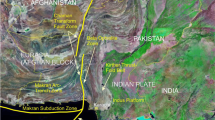Abstract
The recent seismicity of Tunisia is considered sparse and moderate. A number of historical studies are available, but the archaeological evidence has not been properly used. Pilot studies were carried out at three sites in the less seismic middle part of Tunisia: Roman Thysdrus (Arabic El-Jem), and the Islamic medina (old town) of El-Jem, Sousse and Monastir. A selection of earthquake archaeological effects observed is shown (dropped keystones, fractured or extruded masonry blocks, columns displaced from plinth), marking the potential minimum intensity of shaking. To create this level of damage, local intensity IX is hypothesized. This is certainly higher than the 2007 seismic hazard map produced by WHO, where only medium intensities are indicated for the region. It is suggested that a systematic archaeoseismological study of Tunisia will contribute in improving seismic hazard assessment.
Access provided by Autonomous University of Puebla. Download conference paper PDF
Similar content being viewed by others
Keywords
1 Introduction
The recent seismicity of Tunisia is considered sparse and moderate, mostly based on instrumental data. A number of historical studies are available. Utilizing the information hidden in archaeological objects has started only recently: Bahrouni et al. (2019) offered a glimpse in their studies on the archaeological evidence of the AD 859 earthquake in Kairouan.
Recently, the author carried out pilot studies in three sites in the less seismic middle part of Tunisia: Roman Thysdrus (Arabic El-Jem), and the Islamic medina (old town) of El-Jem, Sousse and Monastir. Short list of observed earthquake’s archaeological effects is shown below, marking the potential minimum intensity of shaking (after Rodriguez-Pascua et al. 2011).
2 Methods
Sites were documented by visual observation, photography, and hand drawings. Measurements were taken by a Laser Disto 8 range finder, which allowed quick measuring of horizontal and vertical distances. Observed damage must be interpreted within the context of the building. Work on the details of the history of construction, destruction, and restoration of each site by literature studies is in progress.
3 Results
3.1 El-Jem, Roman Amphitheatre
-
Dropped keystones—VII—frequent in radial arches, rare in tangential arches
-
Dropped arch sectors (Fig. 1a)—VII. This is the highest, ‘severe’ damage category of arches, as understood by Hinzen et al. (2016).
Fig. 1 Seismicity of Tunisia (after Ksentini and Romdhane 2014, modified). Sites in El-Jem, Sousse, and Monastir are within the rectangle. This is where a possibly M > 6.0 earthquake occurred within the last millennium, additionally to the already known three marked by stars
-
Collapsed arches/vaults—IX
-
Extruded blocks (Fig. 1b)—IX(?)
-
Penetrating fracture in arch masonry (Fig. 1c)—parallel to stress—VII. ‘Severe’ damage category of Hinzen et al. (2016).
3.2 Sousse, Ribat and Kasbah (Islamic)
-
Twisted walls (Fig. 2f)—VIII
Fig. 2 Archaeoseismological evidence for damaging earthquakes in the middle part of Tunisia. a Dropped arch sectors. El-Djem amphitheatre. #6085. b Extruded blocks. El-Djem amphitheatre. #6062. c Penetrating fracture in arch masonry—parallel to stress. El-Djem amphitheatre. #6098. d Broken corners of columns: axial and oblique. Sousse, Ribat. #5794. Serial numbers refer to images in the archaeoseismological database (Moro and Kázmér 2019). e Shift between column and capital. Sousse, Ribat. #5800. f Twisted walls. Sousse. #5897. g Extruded masonry block. Sousse. #5805. h Displaced arch sector (fallen keystone). Sousse. #5867
-
Broken corners of columns: axial and oblique (Fig. 1d)—VII
-
Shift between column and capital (Fig. 2e)—IX
-
Penetrating fracture through capital or plinth (Fig. 1d)—VII
-
Extruded masonry block (Fig. 2g)—IX(?)
-
Displaced arch sector (fallen keystone) (Fig. 2h)—VII
-
Axial fracture in tower
-
Column displaced from plinth—IX.
3.3 Monastir, Ribat (Islamic)
-
Column displaced from plinth—IX
-
Broken corners of columns: axial and oblique—VII.
4 Discussion and Conclusion
The current instrumentally recorded seismic activity nearby Sousse produced up to M 4.5 earthquakes (Bahrouni et al. 2014). Historical M 6–7 earthquakes are known in Tunisia (Ksentini and Romdhane 2014). However, their epicentres are more than 200 km away from Sousse: These probably did not cause major damage in public buildings and nearby the city. The archaeoseismic damage outlined above was certainly caused by at least one other major earthquake nearby, during the past millennium. It is suggested that a systematic archaeoseismological survey of Tunisia will change our perception of the seismic hazard of the country.
References
Bahrouni, N., Bouaziz, S., Soumaya, A., Ben Ayef, N. Attafi, K., Houla, Y., El Ghali, A., Rebai, N.: Neotectonic and seismotectonic investigation of seismically active regions in Tunisia: a multidisciplinary approach. J. Seismol. 18, 235–256 (2014)
Bahrouni, N., Meghraoui, M., Hinzen, K., Arfaoui, M., Maamri, R., Mahfoud, F.: Historical and archeoseismic investigations in Kairouan region (central Tunisia): evidence for the 9 October 859 AD large earthquake. In: 2nd Conference of the Arabian Journal of Geosciences, 25–28 November 2019, Sousse, Tunisia (this volume) (2019)
Hinzen, K.-G., Schwellenbach, I., Schweppe, G., Marco, S.: Quantifying earthquake effects on ancient arches, example: the Kalat Nimrod fortress, Dead Sea Fault Zone. Seismol. Res. Lett. 87(3), 751–764 (2016)
Ksentini, A., Romdhane, N.B.: Updated seismic hazard assessment of Tunisia. Bull. Earthquake Eng. 12, 647–670 (2014)
Moro, E., Kázmér, M.: Damage in ancient buildings—towards an archaeoseismological database (2019). (In preparation)
Rodríguez-Pascua, M.A., Silva, P.G., Peérez-López, R., Giner-Robles, J.-L., Martín-González, F., Perucha, M.A.: Preliminary intensity correlation between macroseismic scales (ESI07 and EMS98) and Earth-quake Archaeological Effects (EAEs). In: Proceedings of the 4th International INQUA Meeting on Paleoseismology, Aachen, pp. 221–224 (2011)
WHO: World Health Organization. Seismic Hazard Distribution Map, Tunisia (2007)
Author information
Authors and Affiliations
Editor information
Editors and Affiliations
Rights and permissions
Copyright information
© 2022 The Author(s), under exclusive license to Springer Nature Switzerland AG
About this paper
Cite this paper
Kázmér, M. (2022). Is the Seismic Hazard in Tunisia Underestimated? An Archaeoseismological Study. In: Meghraoui, M., et al. Advances in Geophysics, Tectonics and Petroleum Geosciences. CAJG 2019. Advances in Science, Technology & Innovation. Springer, Cham. https://doi.org/10.1007/978-3-030-73026-0_47
Download citation
DOI: https://doi.org/10.1007/978-3-030-73026-0_47
Published:
Publisher Name: Springer, Cham
Print ISBN: 978-3-030-73025-3
Online ISBN: 978-3-030-73026-0
eBook Packages: Earth and Environmental ScienceEarth and Environmental Science (R0)






